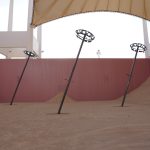Hosted by the Diriyah Biennale Foundation, one of the key highlights of the inaugural edition of the Islamic Arts Biennale taking place between January 23rd and April 23rd 2023 will be the 18 Saudi artists and art collectives, over 40 artworks, and over 200 artefacts from Saudi Arabian institutions that will be presented at the repurposed Western Hajj Terminal at King Abdulaziz International Airport in Jeddah. Under the theme of Awwal Bait (First House), the exhibition will explore how the holy Ka’bah in Makkah Al-Mukarramah and the Prophet’s Mosque in Al-Madinah al-Munawwarah inspires Muslims – on both cultural and metaphysical levels – to create a sense of belonging in their own home, their own ‘bait’, wherever that may be.
For its inaugural edition, the exhibition will showcase some of the world’s leading international artists, alongside commissioned and existing works from both emerging and renowned Saudi artists, including:
• Chain of Knowledge by master calligrapher Abdelrahman Elshahed who beautifully combines calligraphy with lighting elements
• After Hijra, a multi-channel audio installation inspired by a selection of historic tombstones by Sarah Al Abdali
• I Pray for the Rain, a video installation that explores our relationship with water and the human body in ritual ‘wudu’ by Sarah Brahim
• Holy Land, an immersive experience composed of Hajj souvenirs reproduced as sculptures by Sultan bin Fahad
• Garden, a site-specific installation exploring nature as our first home by Ayman Zedani
• Wave Catcher, an installation which places forms in space to give material expression t the call to prayer by artist and researcher Basmah Felemban
• Air Pilgrims Accommodation 1958, an architectural installation that represents pilgrims’ experience of community and reflects on the multifaceted ways in which a building may be used by architects Abdulrahman Gazzaz and Turki Gazzaz of Bricklab Studios
• An Excavated Geography of Oud, a clay-clad structure with audio, that examines the use and appreciation of agarwood in the context of sustainability andc ultural significance by Leen Ajlan
• Anywhere Can Be A Place of Worship an architectural intervention built from palm reeds and sand, amongst other natural elements, by Nojoud Alsudairi and Sara Alissa of Syn Architects
• Tazaamun, an immersive multi-media installation which takes the audience on a journey out of mundane space and time by DAL (Digital Arts Lab)
• Portraits of the Banu Shaibah, the family of the keepers of the Ka’aba keys by master photographer Adel Al-Quraishi
• The Last Tashahud presented as a series of monumental double-sided light boxes embedded in the landscape by Moath Alofi
• The Moment of Arrival, two series of black and white photographs documenting the arrival of Hajj pilgrims in Saudi Arabia by Reem Al Faisal
• City as a Mosque, a large-scale physical excavation with embedded sandstone tiles, LED lights and a viewing platform by Basmah Kaki, Hessa Al Bader and Hussam Dakkak of design and research practice Studio Bound.
• Holy Limits, a work that contemplates the physical boundary of the Holy Mosque by Nasser Al Salem
The extraordinary constellation of artists has been chosen for their media, methods, and practices. They share common themes of spirituality, collectivity and belonging in their work. With their work grounded in the embodied, the aural, in collectivity, and the spiritual, these artists reflect deeply on the generativity of our contexts and practices for the present and the future.
According to Aya Al-Bakree, CEO, Diriyah Biennale Foundation, “The Diriyah Biennale Foundation has placed a special emphasis on nurturing and providing a platform for homegrown talent in its inaugural edition; It’s an exciting, first-of-its kind new stage for the local, regional, and international art community to get inspired by fresh, thought-provoking perspectives on the diversity of the past, present, and future of the Islamic arts from around the world. Local artists from Saudi Arabia have done an incredible job in bringing the sacred aspects of Islam to life through indigenous and modern techniques and media. We are keen for people to join the dialogue and experience, first-hand, the sense of community that the faith can evoke, through art.”
In addition, a distinguished international curatorial team is overseeing the Islamic Arts Biennale: Dr Saad Alrashid, leading Saudi scholar and archaeologist; Dr. Omniya Abdel Barr, Barakat Trust Fellow at the Victoria and Albert Museum and Head of Development at the Egyptian Heritage Rescue Foundation; Dr Julian Raby, Director Emeritus of the National Museum of Asian Art, Smithsonian Institution, Washington DC; and biennale Artistic Director Sumayya Vally, Artistic Director, Principal of Counterspace, and Honorary Professor of Practice, UCL.
For the visitors, the curators have thoughtfully conceptualized a journey that will be brought to life through the diversity of work on display, including photography, installations, video, sculptures, painting, fabric works and more. Audiences will be encouraged to seek inspiration and novel perspectives through the course of the exhibition, which will highlight common themes of spirituality, collectivity and belonging across all the galleries and exhibition spaces.
Press release from Diriyah Biennale Foundation.



